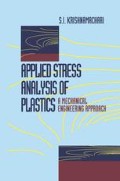Abstract
Fracture mechanics is a relatively new branch of stress analysis. It evolved from the need for a rational explanation of the several brittle failures-without-warning of ship hull structures, railroad structures, etc. which are made of normally ductile metals [1]. The development of fracture mechanics was initiated from several viewpoints. One such viewpoint is the strain energy consideration in a body in which a crack extends by just a small amount. Another approach is the application of linear elasticity for the determination of stress fields at the tip of a crack. Other approaches are equivalent to each other for the elastic behavior of the material in the close vicinity of the crack tip and diverge for plastic flow. Each approach defines its own version of the resistance of the material to fracture, which may be termed fracture toughness. It is used much in the same way as yield strength or ultimate strength is used. Basically, all approaches seek on the one hand, to determine the response of a cracked structure to applied loads, and on the other hand, to provide methods to measure the toughness of the material. The extension of fracture mechanics to plastics involves certain additional considerations. The high plastic flow capability and time dependence are the special characteristics of fracture mechanics as applied to plastics.
Access this chapter
Tax calculation will be finalised at checkout
Purchases are for personal use only
Preview
Unable to display preview. Download preview PDF.
References
Barsom, J. M. and Rolfe, S. T., Fatigue and Fracture Control in Structures—Applications of Fracture Mechanics, 2nd Edn. 1987, Prentice Hall Inc., Englewood Cliffs, NJ.
Griffith, A. A., “The phenomenon of rupture and flow in solids,” Phil. Trans. Roy. Soc., London, A-221, pp 163–198, 1920.
Williams, J. G., Fracture Mechanics of Polymers, 1984, Ellis Horwood Ltd., Chichester, U.K.
Timoshenko, S. P. and Goodier, J. N., Theory of Elasticity, 3rd Edn. 1970, McGraw Hill, New York, NY.
Irwin, G. R, “Plastic zone near a crack and fracture toughness,” Proc. 7th Sagamore Conf. p IV-63, 1960.
Sih, G. C., Handbook of Stress—Intensity Factors—Stress Intensity Factor Solutions and Formulas for Reference, 1973, Institute of Fracture and Solid Mechanics, Lehigh University, Bethlehem, PA.
Rooke, D. O. and Cartwright, D. J., Compendium of Stress Intensity Factors, 1974, Her Majesty’s Stationery Office, London.
Hiroshi Tada, Paris, P. C., and Irwin, G. R., The Stress Analysis of Cracks Handbook, 1973, Del Research Corporation.
Rice, J. R., “A path independent integral and the approximate analysis of strain concentration by notches and cracks,” J. of Applied Mechanics, Vol. 35, pp 379–386, 1968.
Wells, A. A., “Unstable crack propagation in metals: Damage and fast fracture,” Proceedings of the Crack Propagation Symposium, The College of Aeronautics, Vol. 1, pp 210–230, 1962, Cranefield, U.K.
Williams, J. G., “Linear fracture mechanics,” Chapter 2 in Advances in Polymer Science, Number 27,Failure in Polymers edited by Hans-Joachim Cantow, et al., 1978, Springer-Verlag, Berlin.
Williams, J. G., Stress Analysis of Polymers, Chapter 7, 2nd Edn. Ellis Horwood Ltd., Chichester, U.K.
ASTM Subcommittee D20.10.21 on Fracture Mechanics, Standard Test Methods for Plane-Strain Fracture Toughness and Strain Energy Release Rate of Plastic Materials, Project No. X-10–128 April 1990.
Dugdale, D. S., “Yielding of steel sheets containing slits,” J. of the Mechanics and Physics of Solids, Vol. 8, p 100, 1960.
Hertzberg, R. W. and Manson, J. A., Fatigue of Engineering Plastics, 1980, Academic Press, New York, NY.
Broek, D., Elementary Engineering Fracture Mechanics, 3rd Edn. 1982, Martinus Nijhoff Publishers, Boston, MA.
Ewalds, H. L. and Wanhill, R. J. H., Fracture Mechanics, 1984, Co-published by Edward Arnold and Delftse Uitgevers Maatschappij, Delft, Netherlands.
Paris, P. C. and Sih, G. C., ASTM STP 381, American Society for Testing and Materials, Philadelphia, 1964.
Author information
Authors and Affiliations
Rights and permissions
Copyright information
© 1993 Springer Science+Business Media New York
About this chapter
Cite this chapter
Krishnamachari, S.I. (1993). Fracture Mechanics. In: Applied Stress Analysis of Plastics. Springer, Boston, MA. https://doi.org/10.1007/978-1-4615-3110-4_6
Download citation
DOI: https://doi.org/10.1007/978-1-4615-3110-4_6
Publisher Name: Springer, Boston, MA
Print ISBN: 978-0-442-23907-7
Online ISBN: 978-1-4615-3110-4
eBook Packages: Springer Book Archive

